編輯:關於Android編程
效果圖
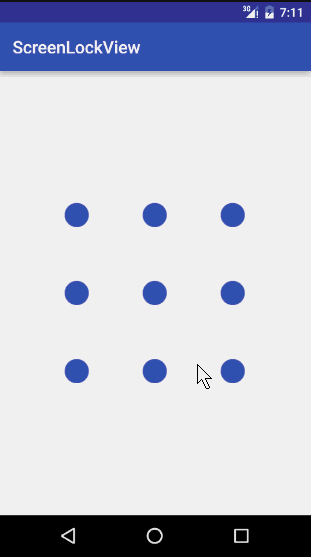
思路
首先我們來分析一下實現九宮格解鎖的思路:當用戶的手指觸摸到某一個點時,先判斷該點是否在九宮格的某一格范圍之內,若在范圍內,則該格變成選中的狀態;之後用戶手指滑動的時候,以該格的圓心為中心,用戶手指為終點,兩點連線。最後當用戶手指抬起時,判斷劃過的九宮格密碼是否和原先的密碼匹配。
大致的思路流程就是上面這樣的了,下面我們可以來實踐一下。
Point 類
我們先來創建一個 Point 類,用來表示九宮格鎖的九個格子。除了坐標 x ,y 之外,還有三種模式:正常模式、按下模式和錯誤模式。根據模式不同該格子的顏色會有所不同,這會在下面中說明。
public class Point {
private float x;
private float y;
// 正常模式
public static final int NORMAL_MODE = 1;
// 按下模式
public static final int PRESSED_MODE = 2;
// 錯誤模式
public static final int ERROR_MODE = 3;
private int state = NORMAL_MODE;
// 表示該格的密碼,比如“1”、“2”等
private String mark;
public String getMark() {
return mark;
}
public void setMark(String mark) {
this.mark = mark;
}
public Point(float x, float y, String mark) {
this.x = x;
this.y = y;
this.mark = mark;
}
public int getState() {
return state;
}
public void setState(int state) {
this.state = state;
}
public float getX() {
return x;
}
public void setX(float x) {
this.x = x;
}
public float getY() {
return y;
}
public void setY(float y) {
this.y = y;
}
}
RotateDegrees類
有了上面的 Point 類之後,我們還要創建一個 RotateDegrees 類,主要作用是計算兩個 Point 坐標之間的角度:
public class RotateDegrees {
/**
* 根據傳入的point計算出它們之間的角度
* @param a
* @param b
* @return
*/
public static float getDegrees(Point a, Point b) {
float degrees = 0;
float aX = a.getX();
float aY = a.getY();
float bX = b.getX();
float bY = b.getY();
if (aX == bX) {
if (aY < bY) {
degrees = 90;
} else {
degrees = 270;
}
} else if (bY == aY) {
if (aX < bX) {
degrees = 0;
} else {
degrees = 180;
}
} else {
if (aX > bX) {
if (aY > bY) { // 第三象限
degrees = 180 + (float) (Math.atan2(aY - bY, aX - bX) * 180 / Math.PI);
} else { // 第二象限
degrees = 180 - (float) (Math.atan2(bY - aY, aX - bX) * 180 / Math.PI);
}
} else {
if (aY > bY) { // 第四象限
degrees = 360 - (float) (Math.atan2(aY - bY, bX - aX) * 180 / Math.PI);
} else { // 第一象限
degrees = (float) (Math.atan2(bY - aY, bX - aX) * 180 / Math.PI);
}
}
}
return degrees;
}
/**
* 根據point和(x,y)計算出它們之間的角度
* @param a
* @param bX
* @param bY
* @return
*/
public static float getDegrees(Point a, float bX, float bY) {
Point b = new Point(bX, bY, null);
return getDegrees(a, b);
}
}
ScreenLockView 類
然後我們要先准備好關於九宮格的幾張圖片,比如在九宮格的格子中,NORMAL_MODE 模式下是藍色的,被手指按住時九宮格的格子是綠色的,也就是對應著上面 Point 類的中 PRESSED_MODE 模式,還有 ERROR_MODE 模式下是紅色的。另外還有圓點之間的連線,也是根據模式不同顏色也會不同。在這裡我就不把圖片貼出來了。
有了圖片資源之後,我們要做的就是先在構造器中加載圖片:
public class ScreenLockView extends View {
private static final String TAG = "ScreenLockView";
// 錯誤格子的圖片
private Bitmap errorBitmap;
// 正常格子的圖片
private Bitmap normalBitmap;
// 手指按下時格子的圖片
private Bitmap pressedBitmap;
// 錯誤時連線的圖片
private Bitmap lineErrorBitmap;
// 手指按住時連線的圖片
private Bitmap linePressedBitmap;
// 偏移量,使九宮格在屏幕中央
private int offset;
// 九宮格的九個格子是否已經初始化
private boolean init;
// 格子的半徑
private int radius;
// 密碼
private String password = "123456";
// 九個格子
private Point[][] points = new Point[3][3];
private int width;
private int height;
private Matrix matrix = new Matrix();
private float moveX = -1;
private float moveY = -1;
// 是否手指在移動
private boolean isMove;
// 是否可以觸摸,當用戶抬起手指,劃出九宮格的密碼不正確時為不可觸摸
private boolean isTouch = true;
// 用來存儲記錄被按下的點
private List<Point> pressedPoint = new ArrayList<>();
// 屏幕解鎖監聽器
private OnScreenLockListener listener;
public ScreenLockView(Context context) {
this(context, null);
}
public ScreenLockView(Context context, AttributeSet attrs) {
this(context, attrs, 0);
}
public ScreenLockView(Context context, AttributeSet attrs, int defStyleAttr) {
super(context, attrs, defStyleAttr);
errorBitmap = BitmapFactory.decodeResource(getResources(), R.drawable.bitmap_error);
normalBitmap = BitmapFactory.decodeResource(getResources(), R.drawable.bitmap_normal);
pressedBitmap = BitmapFactory.decodeResource(getResources(), R.drawable.bitmap_pressed);
lineErrorBitmap = BitmapFactory.decodeResource(getResources(), R.drawable.line_error);
linePressedBitmap = BitmapFactory.decodeResource(getResources(), R.drawable.line_pressed);
radius = normalBitmap.getWidth() / 2;
}
...
}
在構造器中我們主要就是把圖片加載完成,並且得到了格子的半徑,即圖片寬度的一半。
之後我們來看看 onMeasure(int widthMeasureSpec, int heightMeasureSpec) 方法:
@Override
protected void onMeasure(int widthMeasureSpec, int heightMeasureSpec) {
int widthSize = MeasureSpec.getSize(widthMeasureSpec);
int widthMode = MeasureSpec.getMode(widthMeasureSpec);
int heightSize = MeasureSpec.getSize(heightMeasureSpec);
int heightMode = MeasureSpec.getMode(heightMeasureSpec);
if (widthSize > heightSize) {
offset = (widthSize - heightSize) / 2;
} else {
offset = (heightSize - widthSize) / 2;
}
setMeasuredDimension(widthSize, heightSize);
}
在 onMeasure(int widthMeasureSpec, int heightMeasureSpec) 方法中,主要得到對應的偏移量,以便在下面的 onDraw(Canvas canvas) 把九宮格繪制在屏幕中央。
下面就是 onDraw(Canvas canvas) 方法:
@Override
protected void onDraw(Canvas canvas) {
if (!init) {
width = getWidth();
height = getHeight();
initPoint();
init = true;
}
// 畫九宮格的格子
drawPoint(canvas);
if (moveX != -1 && moveY != -1) {
// 畫直線
drawLine(canvas);
}
}
首先判斷了是否為第一次調用 onDraw(Canvas canvas) 方法,若為第一次則對 points 進行初始化:
// 初始化點
private void initPoint() {
points[0][0] = new Point(width / 4, offset + width / 4, "0");
points[0][1] = new Point(width / 2, offset + width / 4, "1");
points[0][2] = new Point(width * 3 / 4, offset + width / 4, "2");
points[1][0] = new Point(width / 4, offset + width / 2, "3");
points[1][1] = new Point(width / 2, offset + width / 2, "4");
points[1][2] = new Point(width * 3 / 4, offset + width / 2, "5");
points[2][0] = new Point(width / 4, offset + width * 3 / 4, "6");
points[2][1] = new Point(width / 2, offset + width * 3 / 4, "7");
points[2][2] = new Point(width * 3 / 4, offset + width * 3 / 4, "8");
}
在 initPoint() 方法中主要創建了九個格子,並設置了相應的位置和密碼。初始化完成之後把 init 置為 false ,下次不會再調用。
回過頭再看看 onDraw(Canvas canvas) 中其他的邏輯,接下來調用了 drawPoint(canvas) 來繪制格子:
// 畫九宮格的格子
private void drawPoint(Canvas canvas) {
for (int i = 0; i < points.length; i++) {
for (int j = 0; j < points[i].length; j++) {
int state = points[i][j].getState();
if (state == Point.NORMAL_MODE) {
canvas.drawBitmap(normalBitmap, points[i][j].getX() - radius, points[i][j].getY() - radius, null);
} else if (state == Point.PRESSED_MODE) {
canvas.drawBitmap(pressedBitmap, points[i][j].getX() - radius, points[i][j].getY() - radius, null);
} else {
canvas.drawBitmap(errorBitmap, points[i][j].getX() - radius, points[i][j].getY() - radius, null);
}
}
}
}
在繪制格子還是很簡單的,主要分為了三種:普通模式下的格子、按下模式下的格子以及錯誤模式下的格子。
onTouchEvent
在繪制好了格子之後,我們先不看最後的 drawLine(canvas) 方法,因為繪制直線是和用戶手指的觸摸事件息息相關的,所以我們先把目光轉向 onTouchEvent(MotionEvent event) 方法:
@Override
public boolean onTouchEvent(MotionEvent event) {
if (isTouch) {
float x = event.getX();
float y = event.getY();
Point point;
switch (event.getAction()) {
case MotionEvent.ACTION_DOWN:
// 判斷用戶觸摸的點是否在九宮格的任意一個格子之內
point = isPoint(x, y);
if (point != null) {
point.setState(Point.PRESSED_MODE); // 切換為按下模式
pressedPoint.add(point);
}
break;
case MotionEvent.ACTION_MOVE:
if (pressedPoint.size() > 0) {
point = isPoint(x, y);
if (point != null) {
if (!crossPoint(point)) {
point.setState(Point.PRESSED_MODE);
pressedPoint.add(point);
}
}
moveX = x;
moveY = y;
isMove = true;
}
break;
case MotionEvent.ACTION_UP:
isMove = false;
String tempPwd = "";
for (Point p : pressedPoint) {
tempPwd += p.getMark();
}
if (listener != null) {
listener.getStringPassword(tempPwd);
}
if (tempPwd.equals(password)) {
if (listener != null) {
listener.isPassword(true);
}
} else {
for (Point p : pressedPoint) {
p.setState(Point.ERROR_MODE);
}
isTouch = false;
this.postDelayed(runnable, 1000);
if (listener != null) {
listener.isPassword(false);
}
}
break;
}
invalidate();
}
return true;
}
public interface OnScreenLockListener {
public void getStringPassword(String password);
public void isPassword(boolean flag);
}
public void setOnScreenLockListener(OnScreenLockListener listener) {
this.listener = listener;
}
在 MotionEvent.ACTION_DOWN 中,先在 isPoint(float x, float y) 方法內判斷了用戶觸摸事件的坐標點是否在九宮格的任意一格之內。如果是,則需要把該九宮格的格子添加到 pressedPoint 中:
// 該觸摸點是否為格子
private Point isPoint(float x, float y) {
Point point;
for (int i = 0; i < points.length; i++) {
for (int j = 0; j < points[i].length; j++) {
point = points[i][j];
if (isContain(point, x, y)) {
return point;
}
}
}
return null;
}
// 該點(x,y)是否被包含
private boolean isContain(Point point, float x, float y) {
// 該點的(x,y)與格子圓心的距離若小於半徑就是被包含了
return Math.sqrt(Math.pow(x - point.getX(), 2f) + Math.pow(y - point.getY(), 2f)) <= radius;
}
接下來就是要看 MotionEvent.ACTION_MOVE 的邏輯了。一開始判斷了用戶觸摸的點是否為九宮格的某個格子。但是比 MotionEvent.ACTION_DOWN 還多了一個步驟:若用戶觸摸了某個格子,還要判斷該格子是否已經被包含在 pressedPoint 裡面了。
// 是否該格子已經被包含在pressedPoint裡面了
private boolean crossPoint(Point point) {
if (pressedPoint.contains(point)) {
return true;
}
return false;
}
最後來看看 MotionEvent.ACTION_UP ,把 pressedPoint 裡保存的格子遍歷後得到用戶劃出的密碼,再和預先設置的密碼比較,若相同則回調 OnScreenLockListener 監聽器;不相同則把 pressedPoint 中的所有格子的模式設置為錯誤模式,並在 runnable 中調用 reset() 清空 pressedPoint ,重繪視圖,再回調監聽器。
private Runnable runnable = new Runnable() {
@Override
public void run() {
isTouch = true;
reset();
invalidate();
}
};
// 重置格子
private void reset(){
for (int i = 0; i < points.length; i++) {
for (int j = 0; j < points[i].length; j++) {
points[i][j].setState(Point.NORMAL_MODE);
}
}
pressedPoint.clear();
}
現在我們回過頭來看看之前在 onDraw(Canvas canvas) 裡面的 drawLine(Canvas canvas) 方法:
// 畫直線
private void drawLine(Canvas canvas) {
// 將pressedPoint中的所有格子依次遍歷,互相連線
for (int i = 0; i < pressedPoint.size() - 1; i++) {
// 得到當前格子
Point point = pressedPoint.get(i);
// 得到下一個格子
Point nextPoint = pressedPoint.get(i + 1);
// 旋轉畫布
canvas.rotate(RotateDegrees.getDegrees(point, nextPoint), point.getX(), point.getY());
matrix.reset();
// 根據距離設置拉伸的長度
matrix.setScale(getDistance(point, nextPoint) / linePressedBitmap.getWidth(), 1f);
// 進行平移
matrix.postTranslate(point.getX(), point.getY() - linePressedBitmap.getWidth() / 2);
if (point.getState() == Point.PRESSED_MODE) {
canvas.drawBitmap(linePressedBitmap, matrix, null);
} else {
canvas.drawBitmap(lineErrorBitmap, matrix, null);
}
// 把畫布旋轉回來
canvas.rotate(-RotateDegrees.getDegrees(point, nextPoint), point.getX(), point.getY());
}
// 如果是手指在移動的情況
if (isMove) {
Point lastPoint = pressedPoint.get(pressedPoint.size() - 1);
canvas.rotate(RotateDegrees.getDegrees(lastPoint, moveX, moveY), lastPoint.getX(), lastPoint.getY());
matrix.reset();
Log.i(TAG, "the distance : " + getDistance(lastPoint, moveX, moveY) / linePressedBitmap.getWidth());
matrix.setScale(getDistance(lastPoint, moveX, moveY) / linePressedBitmap.getWidth(), 1f);
matrix.postTranslate(lastPoint.getX(), lastPoint.getY() - linePressedBitmap.getWidth() / 2);
canvas.drawBitmap(linePressedBitmap, matrix, null);
canvas.rotate(-RotateDegrees.getDegrees(lastPoint, moveX, moveY), lastPoint.getX(), lastPoint.getY());
}
}
// 根據point和坐標點計算出之間的距離
private float getDistance(Point point, float moveX, float moveY) {
Point b = new Point(moveX,moveY,null);
return getDistance(point,b);
}
// 根據兩個point計算出之間的距離
private float getDistance(Point point, Point nextPoint) {
return (float) Math.sqrt(Math.pow(nextPoint.getX() - point.getX(), 2f) + Math.pow(nextPoint.getY() - point.getY(), 2f));
}
drawLine(Canvas canvas) 整體的邏輯並不復雜,首先將 pressedPoint 中的所有格子依次遍歷,將它們連線。之後若是用戶的手指還有滑動的話,把最後一個格子和用戶手指觸摸的點連線。
總結
ScreenLockView 中的代碼差不多就是這些了,實現效果還算不錯吧,當然你也可以自己設置喜歡的九宮格圖片,只要替換一下就可以了。如果對本篇文章有疑問可以留言。希望本文的內容對大家開發Android能有所幫助。
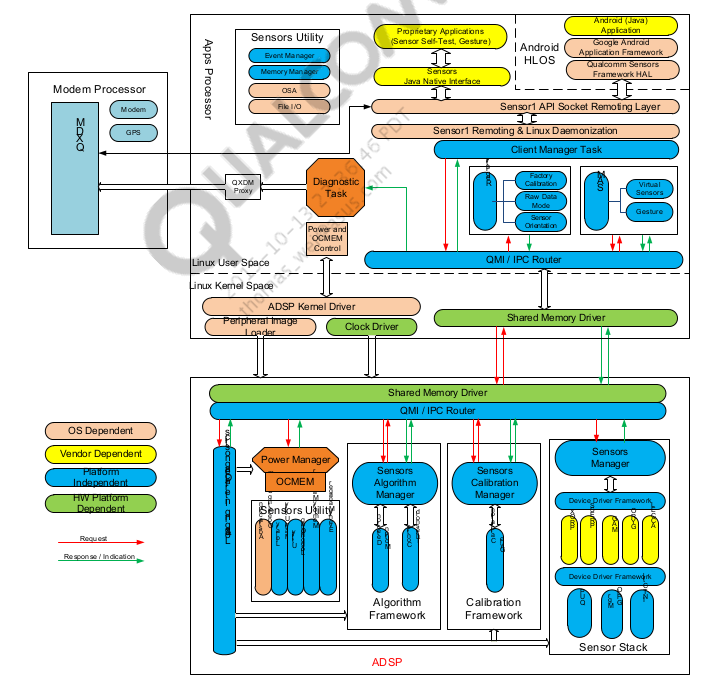 Android Sensor詳解(1)簡介與架構
Android Sensor詳解(1)簡介與架構
序最近在學習有關如何porting sensor的東西,僅借此機會寫博客來督促自己進步,當然如果,有人對博客提出不同的理解,我覺得這是極好的,大家可以共同進步。在這一期的
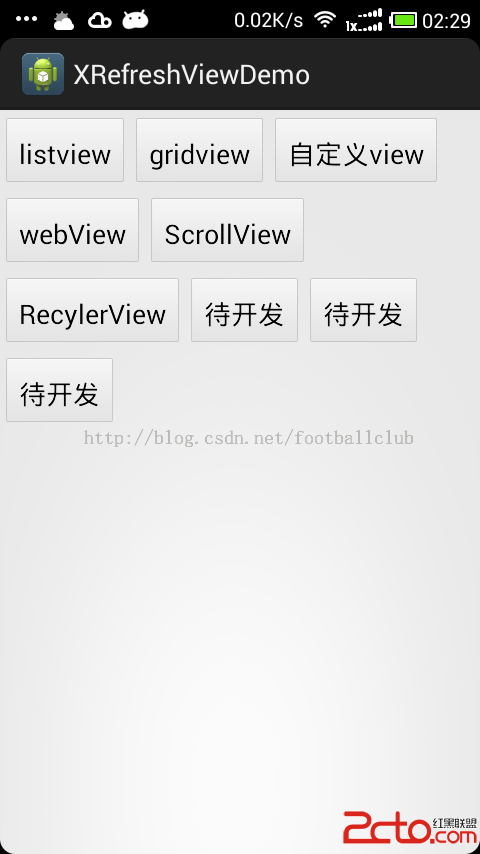 打造android萬能上拉下拉刷新框架——XRefreshView (二)
打造android萬能上拉下拉刷新框架——XRefreshView (二)
一、前言自從上次發表了打造android萬能上拉下拉刷新框架——XRefreshView (一)之後,期間的大半個月一直都很忙,但是我每天晚上下班
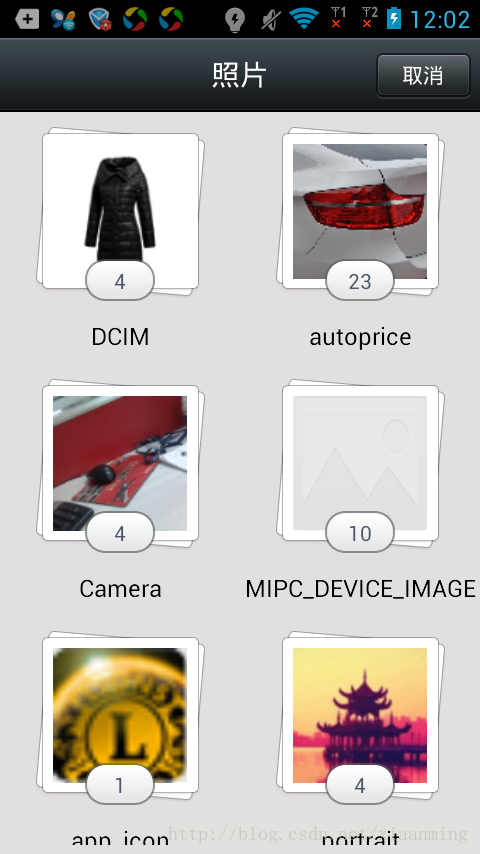 Android應用中使用ContentProvider掃描本地圖片並顯示
Android應用中使用ContentProvider掃描本地圖片並顯示
之前群裡面有朋友問我,有沒有關於本地圖片選擇的Demo,類似微信的效果,他說網上沒有這方面的Demo,問我能不能寫一篇關於這個效果的Demo,於是我研究了下微信的本地圖片
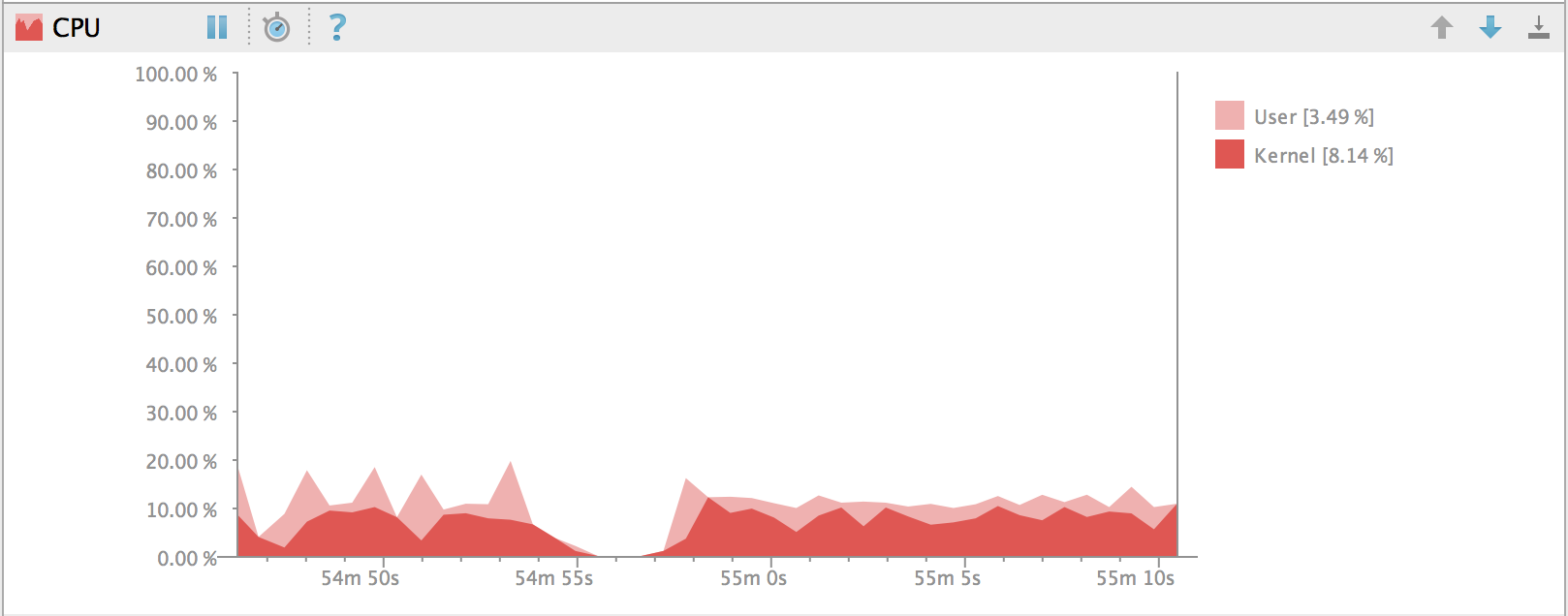 6.3、Android Studio的CPU Monitor
6.3、Android Studio的CPU Monitor
Android Monitor包含一個CPU Monitor,可以讓你非常方便的監測你的應用的CPU的使用。它顯示試試的CPU使用。在CPU Monitor顯示正在運行的